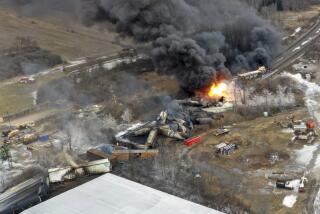To find the needles, reduce the haystack
- Share via
More than nine years into our struggle against catastrophic terrorism, we still don’t know how to find the needles in the civil aviation haystack.
Aviation security has bedeviled us since 2001, in part because we have reacted to past incidents instead of planning strategically for the future. After 9/11 we banned box cutters, scissors and nail clippers; after Richard Reed we started X-raying shoes; after the 2006 London airliner plot we banned liquids over 3 ounces. And now, after a would-be bomber last Christmas hid explosives in his underwear, we are starting to peer beneath passengers’ clothes with scanners.
But what is our overall strategy? Such ad hoc reactions demonstrate a lack of strategic thinking. What we are doing is not completely ineffective. But is it effective enough? And are there better methods? We cannot say because we have not yet done a full analysis or adopted a comprehensive strategy.
If we continue to simply react to the last breach of airport security, we will always lag behind terrorists’ innovations. This will be costly and wasteful in lives, resources and security. A serious strategic review should examine all options, select the best strategy, then monitor, analyze and reassess it regularly. There should also be a quadrennial Homeland Security Department review.
In haystack searches, the first crucial step is to reduce the size of the haystack, so that we are searching all the hay that might contain needles without having to search the whole stack at the airport. In this case, the haystack is all the passengers traveling by air. The needles are terrorists and their weapons. Haystack reduction depends critically on identifying where we should look for the needles. We are not doing that. But there are ways of accomplishing that end while at the same time increasing security and reducing cost. Here are two ideas.
The first is to recognize that the vast majority of passengers are not terrorists. We need to deal with as many of the non-terrorists as possible before they arrive at airport checkpoints. A national, voluntary “trusted passenger” program would do that by advance background checks and biometric identity documents, which could be reviewed, renewed or revoked at any time. Privacy and civil liberties could be protected by strong privacy legislation and oversight by an independent board. Costs could be shared by passengers, airports, airlines and governments.
Although there are a couple of local, commercial programs already in place, they include only a tiny number of passengers. In a truly national program, “trusted” passengers at all airports could move through simplified, expedited check-ins with only occasional random searches.
If, eventually, half of each day’s passengers were to qualify as trusted on domestic flights and a third on international flights, that would be a huge reduction in the size of the haystack. Frequent flyers and airline crews, for example, collectively go through the security routine hundreds of millions of times each year. To what purpose? Imagine what taking even them out of the stack would mean in terms of saving time, money and human resources that could then be focused on the “non-trusted” travelers.
The second idea focuses strategically on identifying the needles, the potential terrorists. Immediately after 9/11, we applied, and then abandoned, special controls on people of certain nationalities. We reacted with similar restrictions after the Christmas bombing attempt. There is no analysis showing that nationality measures are effective, and relaxing them has had no negative effects. Yet, without proof of effectiveness, we repeatedly turn to them. Race, ethnicity and nationality controls are ineffective, knee-jerk reactions. They cost millions and provide no increased security.
Instead of focusing on these factors, we need to develop a much broader profiling program that gives primacy to patterns of activities and behaviors. This profiling would not key primarily on race, ethnicity or nationality, but it would not totally ignore them either. Rather, it would rely primarily on intelligence and law enforcement and on consular, airline and other information related to an individual’s recent and long-term behavior. Only after those factors were examined would others be considered. We have enough data on threatening activities and behaviors to spot “needles” more effectively. We should put more resources into behavioral profiling.
Since 2001, the federal government has studied and revised military strategy several times. It is past time to give aviation security that same kind of scrutiny with an eye to developing an effective strategy for our nation’s airports.
Thomas E. McNamara served as ambassador at large for counterterrorism and as senior advisor for terrorism and homeland security in the State Department. He was ambassador to Colombia from 1988 to 1991.
More to Read
Sign up for The Wild
We’ll help you find the best places to hike, bike and run, as well as the perfect silent spots for meditation and yoga.
You may occasionally receive promotional content from the Los Angeles Times.






